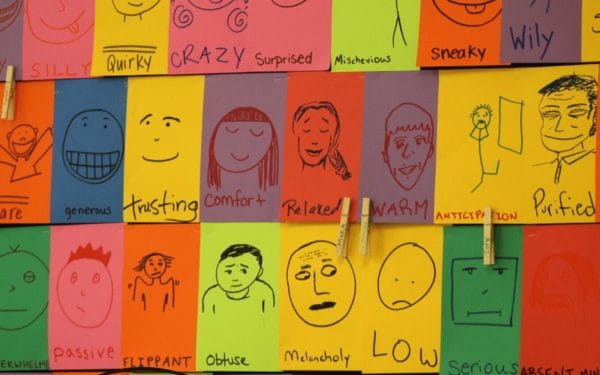The following activity is part of a series we’re creating to support students, teachers, and caregivers, during this unprecedented time. Read more about the project here. If you try this activity with your student(s), we’d love to see what you do. Share your journey via the #Inspired2Learn hashtag on your preferred social platform.
Created by: Judy White and Kelly Kilcoyne
Discipline: Art, Literacy
Age level: All
Time: 30-45 minutes
Materials: Drawing and writing supplies, music
This is an extension of the activity Inside/Outside.
In a moment where the world is especially fraught with change and uncertainty, we are all struggling to observe, name, and adjust to the flood of feelings around and within us. This activity was created in response to that reality.
The joy and challenge for a child may be the discovery that the way they feel, the way they act, the ways others see them can be, and often is different. It is interesting to think about, and to express these differences through art and also, to realize that this feeling – of feeling sometimes one way, then another, is in many ways a shared human experience.
What to Do:
Sometimes one person can have lots and lots of feelings — different from each other. This activity encourages students to explore that experience.
Begin this activity with a discussion inviting learners to name as many feelings as they can and write what they share on a big piece of paper.
To stir the ideas, you might say, “How do you feel if the team you’re playing on is winning?” “If it is losing?” “How do you feel at night, when you go to sleep?” “How do you feel when you don’t know the answer at school?” “How do you feel when someone gives you a surprise? Or makes something special for you? Or tells you something nice about yourself?” Discussions can give rise to numerous shades/colors of feelings to explore and identify and express.
This discussion offers children a way to name and express a rainbow spectrum of feelings, to affirm them all by giving them names, and embracing them as parts of us that are important. The parts of being a human being – a child, a teacher, a mother, a father – that we all share.
In the examples above I’ve omitted feelings like anger, or shame, or embarrassment, or fear, but there’s room , I think, in the Inside/Outside activity to explore scary feelings with color and sound and movement if words, at first seem too scary.
After the discussion, consider playing with the feelings and descriptions that arose in various physical ways. Begin each action with the phrase, “Sometimes I feel like _____.” Filling the blank with the words they generated. Action examples include:
- Playing music to move to that illustrates wildly different feelings and moods.
- Inviting learners to freeze themselves into a pose that shows what they feel like when they have that feeling.
- Using just faces, make expressions that represent these feelings.
Extend the experience by changing the prompt but still using embodied movement to explore the feelings:
“When I feel__________, I want to _____________.”
After spending time with myriad feelings, you may want to have a debriefing discussion. Consider questions like, “What did it feel like to feel so many different things?” “Do you ever feel that mix of feelings all at once? When?” “How long do you usually feel that way?” “What kinds of things happen to change your feelings?”
Experiences like this can help students to observe their own reactions and become more mindful of their feelings. At a time of heightened emotion, such awareness can be empowering and open up important conversations.
Inspired Teaching connection:
An activity like this taps into each of the 4 I’s, Intellect, Inquiry, Imagination, and Integrity. Validating the feelings we have inside and the ways in which they make us human reinforces mutual respect between adults and children. As adults share their own experiences and participate in the actions, they demonstrate the common ground that transcends any age difference between them and their students. In addition, the prompts and conversation situate students as experts with their lived experiences at the center of both the discussion and the physical activities that stem from it.
See our instructional model here.

